
Images of the Perseus cluster from the ROSAT satellite in 1993 showed that there was some interesting structure in the X-ray gas. This has taken some years to explain and brings together astronomers from both ends of the energy spectrum.
As the gas in the ICM is emitting X-rays and as such it must be cooling, much like a red hot poker cools by emitting infra-red radiation. Cooler gas exerts less pressure than hot gas and so if the gas cools it would not be able to support the layers further out. Cooler gas also becomes denser, which means that it cools faster. Hence the outer layers should flow inwards, a so called "Cooling Flow." However results from the CHANDRA and XMM-NEWTON satellites show that there is not as much cool gas present in these clusters then is predicted from their X-ray emission - the Cooling Flow Problem. Mixing the hot gas with the cold gas does not seem to solve this problem. Recently there have been investigations as to whether conduction of heat from the hot outer layers to the cool inner regions of the cluster could solve the problem, but this does not work either.
There is no pile up of gas at a particular temperature either which implies that there is gentle heating at a range of temperatures, as nothing else explains easily why the gas doesn't cool. This problem has implications for galaxy formation as the stars and gas in galaxies has its origins in inter-galactic space. It flowed down onto the proto-galaxy in a smaller scale cooling flow, and so the answer this Cooling Flow Problem may limit the maximum size of galaxies which can form.
The conduction processes in the ICM are a little strange. The ICM is at a temperature of 10 million degrees (107K). However in some clusters there are structures which are very much cooler - at 3000K, which are embedded in this gas. These are filaments of gas which are visible in the light of Hydrogen. Click here to see an image of the filaments. Some of them can also be seen in the X-ray images, implying that there is some contact between the filaments and the ICM. Recent observations carried out by members of the group have shown there to be molecular Hydrogen at 100's K present in these filaments as well. How these filaments can exist in the extremely hot ICM without evaporating is a question which is currently undergoing research.After the Second World War radar operators turned their expertise to the sky and the subject of radio astronomy was invented. Scanning the sky with antennae revealed many sources, some of which were point sources and very bright, and others which were extended and symmetrical. They emit radio waves because there are electrons moving in magnetic fields, which causes synchrotron radiation.
What is thought to occur is that there is a super massive black hole at the centre of such a source. This black hole attracts large amounts of material which falls in towards it in an accretion disc. This disc becomes hot because of friction, and so the disc itself can emit X-rays. Not all the material in the disc is swallowed by the black hole. By some, currently unknown, mechanism black holes produce jets along the rotation axis of the black hole. Such jets are seen in other astrophysical phenomena, for example stellar mass black holes such as SS433, T Tauri stars and other protostars. Jets in extragalactic sources were first noticed in 1918 by H.D.Curtis in M87, as this one is also seen in visible light. These jets are remarkable structures as they are very thin, long and linear stretching over many thousands of light years, and from high resolution radio images they extend right down to the core.
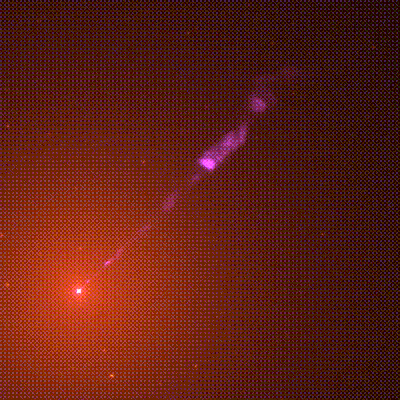 |
| The Jet in M87; the light from the stars is the orange fuzz at the bottom left the image. (Image courtesy HST) |
On larger scales these jets run out of energy, they flare and spread out forming radio lobes which can be much larger than the galaxy which hosts the black hole. These are amongst the largest single structures in the Universe. These sorts of galaxies are one type of a family known as Active Galaxies. The central black hole can also be vey bright at other wavelengths of light and some are so bright that they can be seen to great distances. For more see the section on Active Galactic Nuclei.
When such a galaxy and black hole are at the centre of a cluster of galaxies, the jets plough into the Intra Cluster Medium (ICM). The two types of gas (plasma) do not mix very well, and the jets inflate bubbles in the ICM. This means that there is less X-ray emission coming from some these regions. The radio emission can also fit very cleanly into the holes in the X-ray emission. One of the closest clusters which has a clear anti-correlation between the X-ray and Radio emission is the Perseus Cluster. It is also interesting as it has older bubbles which do not much radio emission associated with them.
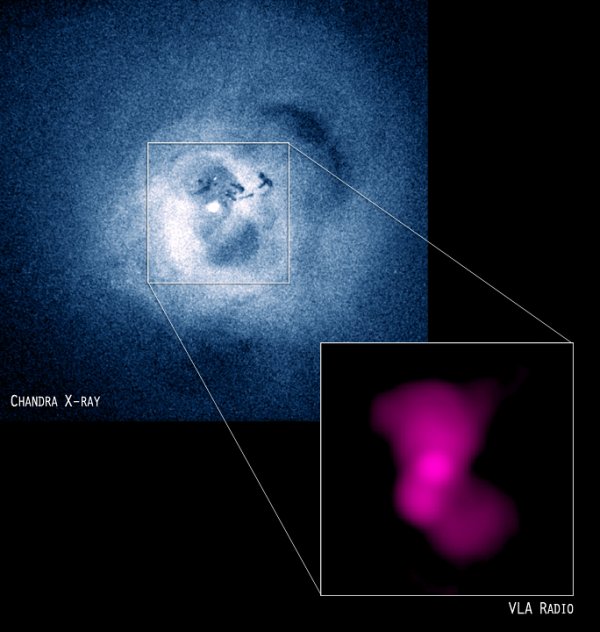 |
| The CHANDRA image of the Perseus Cluster along with the radio emission from the central regions. The radio emission fits neatly inside the cavities in the X-ray emission. (Image courtesy CHANDRA) |
It is thought that these deficits in the X-ray emission are bubbles which are blown in the ICM, as the ones further from the centre of the cluster have a similar shape to "spherical cap bubbles." Another feature found in clusters supports this interpretation; if this cluster is imaged in the wavelength of Hydrogen-alpha, long extended filaments are seen. They appear to be linear, implying that the ICM is not turbulent, and hence viscous. The correlation between the filament to the top-right and the flow pattern behind the rising bubble is very suggestive.
Most clusters which would be expected to have a cooling flow seem to have a radio source at the centre. Currently there is not clear connection between the two, however a radio source pumps a large amount of energy into the ICM over its lifetime (1045 erg/s, or 1038 W) and if this energy could heat the ICM this may be the solution to the Cooling Flow Problem. However, the coupling between the radio source and the ICM is very inefficient, and any form of heating has to work over a large range of cluster types.
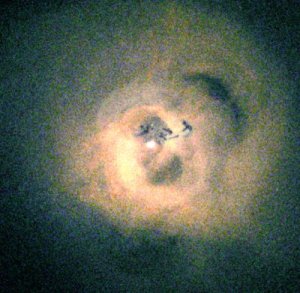 | 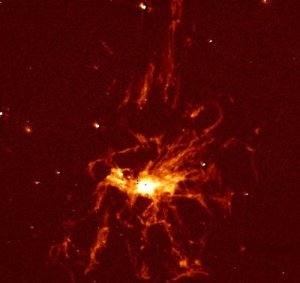 |
| X-ray image of the Perseus cluster - notice the ghost bubbles to the top right of the cluster core(Image courtesy CHANDRA) | Image of the Perseus cluster in a specific light of hydrogen. The filaments are much cooler than the X-ray gas and the one to the top right may trace the flow. |
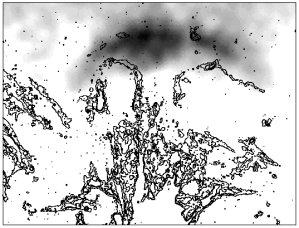 | 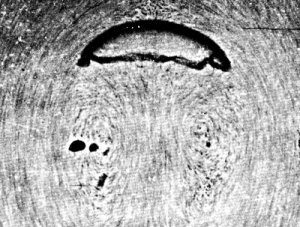 |
| AN overlay of the H-alpha image (contours) onto the X-ray image (grey-scale). | A Spherical Cap bubble rising through water on Earth; very similar to the much larger one on the left. |
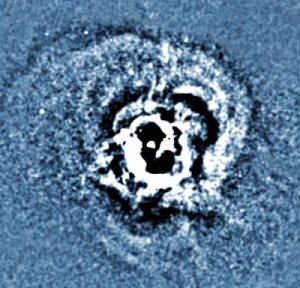 | 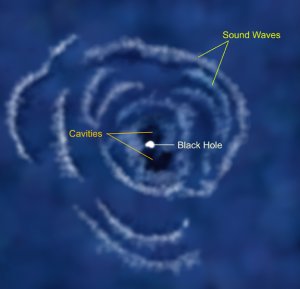 |
| An unsharp masked image of the Perseus Cluster, this technique brings out all of the fine scale and the ripples are very clear. | An illustration showing the ripples. |
For some movies of the inflation of bubbles and the creation of the ripples see the Links section.
These sound waves may actually be the solution to the Cooling Flow Problem alluded to above. The sound waves from the black hole could carry energy into the cluster, heating the gas and so preventing the gas from cooling. The bubbles could also put energy into the ICM as well as mixing the gas from the centre of the cluster with that from further out. The ICM is thought to be viscous, because the bubbles form smooth shapes and the filaments are very linear, and this would allow the transfer of energy between the black hole and the ICM.
Since the discovery of these bubbles in the clusters simulations of their effect on the cluster evolution and properties have been carried out. The simulations have shown that viscosity or magnetic fields are required to keep the bubbles together, otherwise they break up very quickly. They also show that sound waves propagate freely into the ICM and could provide some heating, though whether it will be enough is still a matter for debate.
This topic of research into Clusters of Galaxies is moving forward rapidly and is very active within the group here in Cambridge.
BACK: Clusters - Introduction UP: Clusters - Introduction NEXT: Evolution & Substructure